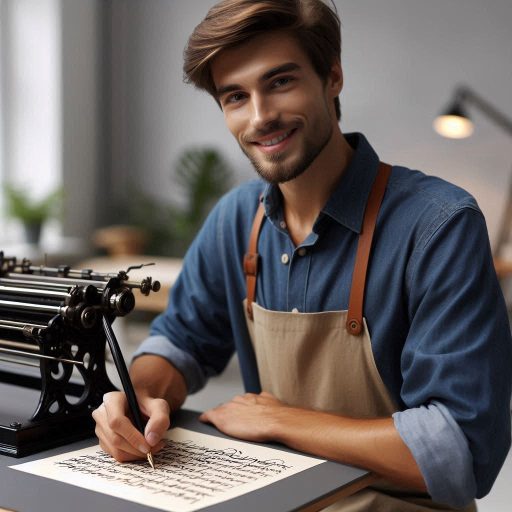Introduction
Calligraphy is a beautiful art form that involves creating decorative lettering, often used for invitations, artwork, and signage.
It requires precision and skill to achieve elegant and stylish compositions.
Having the right tools is crucial for modern calligraphers to produce high-quality work.
The tools not only help in enhancing the artistic expression but also make the process smoother and more efficient.
Paper
When it comes to calligraphy, choosing the right paper is crucial for achieving the best results.
Different types of paper can impact the way your ink flows and how the final piece looks.
Here are some key points to consider when selecting paper for calligraphy:
Different types of paper suitable for calligraphy
- Watercolor paper: known for its thickness and ability to handle wet media.
- Vellum: a smooth and translucent paper that works well for intricate lettering.
- Parchment paper: offers a vintage look and smooth surface for calligraphy.
- Cardstock: a heavy-weight paper ideal for practice and final pieces.
- Rice paper: lightweight and slightly translucent, perfect for brush calligraphy.
- Marker paper: designed for markers and pens, great for modern calligraphy styles.
Factors to consider when choosing paper for calligraphy
- Texture: The texture of the paper can impact how the ink adheres to the surface.
Smooth papers work well for intricate details, while textured papers can add a unique touch to your work. - Weight: The weight of the paper refers to its thickness.
Heavier papers are more durable and less likely to bleed through, making them ideal for calligraphy work. - Color: The color of the paper can enhance the overall look of your calligraphy piece.
Consider how the ink will appear on different colored backgrounds.
Recommended brands of calligraphy paper
- Rhodia: known for its smooth and high-quality paper that works well with various inks.
- Strathmore: offers a range of calligraphy paper suitable for different styles and techniques.
- Canson: known for its affordability and versatility, great for beginners and experienced calligraphers.
- Arches: a top choice for professional calligraphers, known for its durability and quality.
- Maruman: offers a selection of calligraphy papers designed for specific styles like brush calligraphy.
Investing in good quality paper is essential for modern calligraphers looking to elevate their craft.
Consider the type of paper that best suits your style and practice, and don’t be afraid to experiment with different textures, weights, and colors to find what works best for you.
Read: Career Paths for Art and Design Professionals
Pens and nibs
Calligraphy is a beautiful art form that requires precision and attention to detail.
One of the essential tools for modern calligraphers is a good set of pens and nibs.
There are various types of pens and nibs available, each serving a different purpose in creating stunning calligraphy pieces.
Below is an overview of the different types of calligraphy pens and nibs, tips on choosing the right one for your style, and maintenance tips for keeping them in excellent condition.
Types of pens and nibs
- Dip pens: Dip pens are a popular choice among calligraphers as they offer flexibility in creating different line variations.
They require dipping in ink periodically for use. - Fountain pens: Fountain pens are another option for calligraphers, providing a smoother writing experience and consistent ink flow.
They come in various nib sizes for different styles. - Brush pens: Brush pens are ideal for creating bold and expressive strokes in calligraphy.
They come in different sizes and are perfect for modern calligraphy styles. - Italic pens: Italic pens have a flat edge nib that allows for thick and thin lines, making them suitable for italic and Roman calligraphy styles.
Choosing the right pen or nib
When selecting a pen or nib for your calligraphy work, consider the style you want to achieve.
Different pens and nibs offer varying line widths and flexibility, so choose one that aligns with your desired outcome.
Experiment with different pens to find what works best for you.
Maintenance tips
- Clean your pens and nibs regularly to prevent clogging and ensure smooth ink flow.
Use a mild soap and warm water to clean off dried ink. - Store your pens and nibs in a cool, dry place to prevent rusting or damage.
Avoid leaving them in direct sunlight or extreme temperatures. - Replace nibs when they show signs of wear or damage to maintain consistent line quality in your calligraphy work.
By investing in quality pens and nibs and taking care of them properly, you can enhance your calligraphy skills and create beautiful pieces of art.
Experiment with different tools to find what works best for your style, and don’t forget to practice regularly to improve your technique. Happy calligraphy writing!
Read: Calligraphy Techniques for Beginners
Transform Your Career Today
Unlock a personalized career strategy that drives real results. Get tailored advice and a roadmap designed just for you.
Start NowInk
Types of Calligraphy Ink
When it comes to calligraphy, choosing the right ink is crucial for achieving beautiful and consistent results.
There are different types of inks available in the market, each with its own unique characteristics and properties.
Here are some common types of calligraphy ink:
- Water-based ink: Ideal for beginners, as it is easy to work with and dries quickly.
- Acrylic ink: Known for its vibrant colors and waterproof nature, perfect for various surfaces.
- Sumi ink: A traditional Japanese ink made from soot, which produces rich and deep black tones.
Factors to consider when choosing ink for calligraphy
When choosing ink for calligraphy, there are several factors to consider to ensure optimal results.
These factors include:
- Viscosity: The thickness of the ink affects the flow and saturation of the strokes.
- Drying time: Some inks dry quickly, while others may take longer to ensure smudge-free writing.
- Compatibility with paper: Certain inks work better on specific types of paper, so it’s essential to test beforehand.
Recommended brands of calligraphy ink
There are various brands of calligraphy ink available in the market, known for their quality and reliability.
Some of the recommended brands include:
- Dr. Ph. Martin’s Bombay India Ink: A favorite among calligraphers for its intense colors and smooth flow.
- Winsor & Newton Calligraphy Ink: Known for its consistency and suitability for different nibs.
- Kuretake Sumi Ink: Highly regarded for its rich black color and authentic traditional feel.
It’s essential to experiment with different types and brands of ink to find the perfect match for your calligraphy style and preferences.
Investing in high-quality ink will elevate your work and make the writing process more enjoyable and satisfying.
Read: Case Study: Successful Mural Projects in America

Ruler and T-square
Having a ruler and T-square is essential for modern calligraphers because of the importance of straight lines in calligraphy.
These tools help in creating precise lines and angles, resulting in cleaner and more professional-looking work.
Importance of straight lines in calligraphy
- Straight lines are fundamental in calligraphy as they form the basic structure of letters and designs.
- Consistent straight lines contribute to the overall aesthetic appeal of the final piece.
- Mastering the art of creating straight lines is crucial for achieving balance and harmony in calligraphy compositions.
How rulers and T-squares help in creating precise lines and angles
- Rulers provide a straight edge that can be used to guide the pen or brush for creating straight lines.
- T-squares are especially helpful in creating perfect right angles, essential in creating uniform letterforms.
- Both tools work together to ensure accuracy and consistency in the placement of lines and angles.
Tips for using rulers and T-squares effectively in calligraphy
- Choose rulers and T-squares that are made of durable materials to withstand frequent use.
- Position the ruler or T-square securely on the paper to avoid any movement while drawing lines.
- Use light pencil marks to indicate where the ruler or T-square should be placed for optimal results.
- Practice drawing lines with rulers and T-squares to improve your precision and control over the tools.
- Experiment with different angles and line variations to expand your creative possibilities in calligraphy.
By incorporating rulers and T-squares into your calligraphy practice, you can elevate the quality of your work and refine your skills as a modern calligrapher.
These tools not only aid in creating consistent and precise lines but also enhance the overall visual impact of your calligraphy pieces.
Remember to practice regularly and experiment with different techniques to maximize the potential of rulers and T-squares in your calligraphy journey.
Read: How to Maintain and Restore Outdoor Murals
Lightbox
Uses of a lightbox in calligraphy
A lightbox is an essential tool for modern calligraphers.
It offers numerous uses that enhance your calligraphy skills.
One primary use is tracing. By placing a reference image beneath the lightbox, you can easily trace letters and designs.
Showcase Your Business Today
Reach thousands of readers actively exploring professional services. Publish your business profile and grow your audience now.
Publish NowThis technique helps you practice and improve your hand movements.
Additionally, a lightbox facilitates sketching.
You can create initial sketches of your designs before applying ink.
Different types of lightboxes available for calligraphers
Different types of lightboxes cater to various calligraphy needs.
Traditional lightboxes use fluorescent lights and come in various sizes.
They provide a bright, even light that helps visibility.
However, LED lightboxes have gained popularity.
They are more energy-efficient and offer adjustable brightness levels.
Some lightboxes even come with a color temperature adjustment feature.
This flexibility allows you to choose the best lighting for your work.
Recommendations for purchasing a lightbox for calligraphy
When purchasing a lightbox for calligraphy, consider several factors. First, choose the right size.
A larger lightbox accommodates bigger projects but may be cumbersome.
Next, evaluate the brightness and light quality.
A lightbox with adjustable brightness enhances your ability to see intricate details.
Look for a model with a thin profile for portability and convenience.
Additionally, check for durability. A sturdy lightbox withstands frequent use and transport.
Read reviews from fellow calligraphers to find reliable brands. Lastly, consider your budget.
While high-end models offer great features, affordable options can also deliver excellent results.
In summary, a lightbox is an invaluable tool for calligraphers.
It aids in tracing and sketching, allowing for precise work.
By selecting the right type and size, you can enhance your calligraphy practice significantly.
You Might Also Like: How to Become a Successful Landscape Architect
Erasers and correction tools
When it comes to calligraphy, erasers and correction tools are essential for any modern calligrapher.
Importance of Erasers and Correction Tools in Calligraphy
One of the key aspects of calligraphy is precision and accuracy.
However, mistakes are bound to happen even to the most experienced calligraphers.
This is where erasers and correction tools come into play.
Different Types of Erasers Suitable for Calligraphy Work
There are several types of erasers that are suitable for calligraphy work.
- Vinyl Erasers: These are gentle on paper and are perfect for light pencil marks.
- Kneaded Erasers: These are moldable and can be shaped to erase small details accurately.
- White Plastic Erasers: These are great for erasing graphite and colored pencil marks without smudging.
- Pencil Erasers: These are attached to the end of a pencil and are convenient for on-the-go corrections.
Tips for Correcting Mistakes in Calligraphy Without Damaging the Paper
Correcting mistakes in calligraphy can be tricky, especially when working with delicate paper.
Here are some tips to help you correct mistakes without damaging the paper:
- Use a light touch: When erasing, apply gentle pressure to avoid tearing the paper.
- Work slowly and carefully: Take your time when correcting mistakes to ensure precision.
- Avoid using too much pressure: Excessive pressure can leave impressions on the paper.
- Test on a scrap piece of paper: Before erasing on your calligraphy piece, test the eraser on a scrap piece of paper to see how it performs.
- Use the correct eraser: Different erasers are suitable for different types of ink and paper, so make sure you choose the right one for the job.
By following these tips and using the right erasers and correction tools, you can easily correct mistakes in your calligraphy work without compromising the quality of your final piece.
You Might Also Like: How to Start a Career in Jewelry Design
See Related Content: Understanding the Design Process in Industrial Design
Brush pens
In the world of calligraphy, brush pens are essential tools that offer a unique and versatile writing experience.
They combine the flexibility of a brush with the convenience of a pen, making them popular among modern calligraphers.
Here’s an in-depth look at brush pens and how they can elevate your calligraphy game:
Overview of brush pens and their benefits for calligraphy
Brush pens consist of a brush-like tip attached to a pen body filled with ink.
They are available in various tip sizes, colors, and ink types, catering to different preferences.
Brush pens offer more control and precision compared to traditional brushes, making them ideal for both beginners and experienced calligraphers.
They are portable, mess-free, and easy to use, allowing artists to practice calligraphy anywhere, anytime.
How to choose the right brush pen for different calligraphy styles
- Consider the type of calligraphy you will be doing – broad-edge or pointed pen – to determine the brush pen tip size.
- Test the flexibility of the brush pen tip to ensure it can create thin upstrokes and thick downstrokes effortlessly.
- Choose brush pens with archival-quality ink that is fade-resistant and waterproof for long-lasting artworks.
- Experiment with different brands and models to find the brush pens that suit your hand pressure and writing angle.
Techniques for using brush pens effectively in calligraphy
- Hold the brush pen at a 45-degree angle to the writing surface to achieve optimal stroke thickness variation.
- Practice pressure control by applying light pressure on upstrokes and heavy pressure on downstrokes for dynamic letterforms.
- Use a light touch and fluid motion to create graceful curves and consistent lines in your calligraphy.
- Experiment with different brush pen techniques such as flourishing, bounce lettering, and blending colors to enhance your artwork.
Brush pens are versatile tools that can help you unlock your creativity and master the art of calligraphy.
Showcase Your Business Today
Reach thousands of readers actively exploring professional services. Publish your business profile and grow your audience now.
Publish NowWhether you’re a beginner looking to explore different writing styles or a seasoned calligrapher seeking to push the boundaries of traditional techniques, brush pens are indispensable companions on your artistic journey.
Invest in high-quality brush pens, practice regularly, and unleash your imagination to create stunning calligraphic masterpieces that will leave a lasting impression on viewers.
See Related Content: Future of Packaging Design: Innovations Ahead
Conclusion
Having the right tools is crucial for modern calligraphers.
Quality tools directly influence the outcome of your work.
They enhance precision, allowing for cleaner lines and smoother strokes.
The right tools also boost your creativity.
When you invest in high-quality pens, inks, and papers, you unlock new possibilities.
Quality calligraphy tools can improve your skill level over time.
They help you develop your unique style and flourish in your practice.
A well-made nib can make a significant difference in how ink flows.
Good-quality ink provides richer colors and better consistency.
Premium paper enhances the texture and overall feel of your work.
Don’t underestimate the importance of investing in your craft.
Quality tools are an investment in your artistic journey.
They can elevate your calligraphy from ordinary to extraordinary.
Moreover, having the right tools builds confidence in your abilities.
As you continue your calligraphy journey, prioritize quality over quantity.
Select tools that resonate with your style and needs.
By doing so, you will enjoy the process more and produce remarkable pieces.
Remember, your tools are an extension of your creativity.
Choose wisely and let your passion for calligraphy shine.
[E-Books for Sale]
The Big Book of 500 High-Paying Jobs in America: Unlock Your Earning Potential
$19.99 • 500 High-Paying Jobs • 330 pages
Explore 500 high-paying jobs in America and learn how to boost your career, earn more, and achieve success!
See All 500 High-Paying Jobs of this E-Book
1001 Professions Without a Degree: High-Paying American Jobs You Can Start Now
$19.99 • 1001 Professions Without a Degree • 174 pages
Discover 1001 high-paying jobs without a degree! Unlock career tips, skills, and success strategies for just $19.99!




